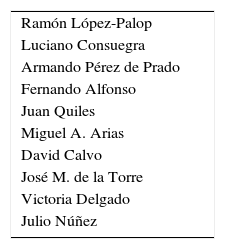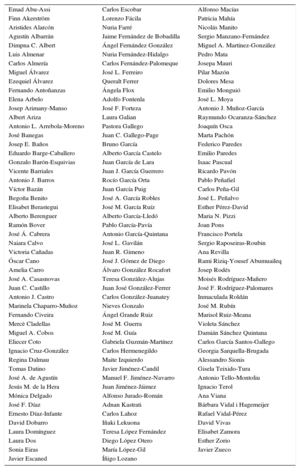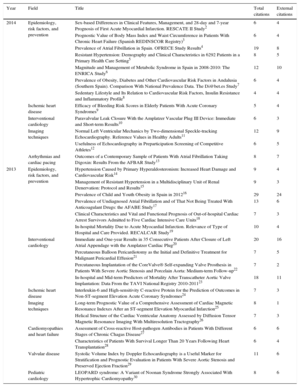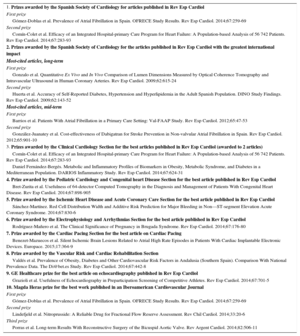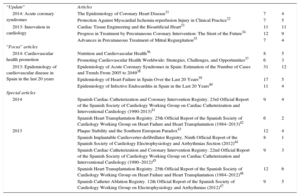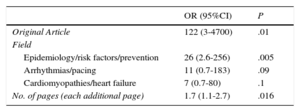The “Editor's Page” is the traditional format for the editorial team (ET) to communicate the overall position of Revista Española de Cardiología (Rev Esp Cardiol) and its plans for the future. The current period is marked by the change in ET that took place in October 2015. In the following pages, the current status of the journal is described by both the outgoing ET, formed by Editor-in-Chief Dr Juan Sanchis and Associate Editors Dr Pablo Avanzas, Dr Antoni Bayes-Genis, and Dr Leopoldo Pérez de Isla, and the new ET, formed by Editor-in-Chief Dr Ignacio Ferreira-González and Associate Editors Dr Emad Abu-Assi, Dr Miguel A. Arias, Dr Pastora Gallego, and Dr Ángel Sánchez-Recalde. These pages also include the posthumous acknowledgement of the excellent work of the beloved Magda Heras, Editor-in-Chief from 2009 to 2014.
As well as providing a brief recap of the scope and organization of Rev Esp Cardiol, this article also describes the results of a new bibliometric analysis, which indirectly summarize the journal's current editorial processes and scientific visibility. This leads on to some brief comments on the editorial plans for the period ahead.
DEFINITION, SCOPE, AND ORGANIZATION OF REVISTA ESPAÑOLA DE CARDIOLOGÍAAs stated in the Statutes of the Spanish Society of Cardiology (SEC), Rev Esp Cardiol is the official scientific publication and institutional communication medium of the SEC. It is defined as an “international journal containing scientific articles on cardiovascular disease”. The journal is written and edited in Spanish and has a high-quality electronic English version.
The ET of the journal is responsible for the scientific evaluation of manuscripts and for setting the editorial policy during its term of office, which involves establishing scientific, institutional, and editorial priorities through new and updated content. The ET is also responsible for maintaining and promoting the website and ensuring an online presence on social and professional networks. The journal also has an Editorial Committee of 8 professionals who collaborate on the production of scientific guidelines and an Editorial Board of more than 200 professionals (among them, the International Editorial Board of more than 40 experts, and 14 advisors on methodology and biostatistics) whose mission is to collaborate on the assessment of the original articles received and to write editorial and review articles at the request of the ET. There are also collaborators who review manuscripts periodically and an Honorary Board of 15 prestigious professionals. Each journal issue contains a list of board members. Table 1 lists the best referees in 2015. In addition, Table 2 lists the names of the professionals who have collaborated with Rev Esp Cardiol but who did not belong to any of the boards in 2015; we would like to acknowledge their excellent work. As is customary in the ET changeover period, there is a new Editorial Board. Such changes promote the incorporation of younger researchers, who perform excellent work through their reviews.
Professionals who Collaborated With Revista Española de Cardiología in 2015
| Emad Abu-Assi | Carlos Escobar | Alfonso Macías |
| Finn Akerström | Lorenzo Fácila | Patricia Mahía |
| Aristides Alarcón | Nuria Farré | Nicolás Manito |
| Agustín Albarrán | Jaime Fernández de Bobadilla | Sergio Manzano-Fernández |
| Dimpna C. Albert | Ángel Fernández González | Miguel A. Martínez-González |
| Luis Almenar | Nuria Fernández-Hidalgo | Pedro Mata |
| Carlos Almería | Carlos Fernández-Palomeque | Josepa Mauri |
| Miguel Álvarez | José L. Ferreiro | Pilar Mazón |
| Ezequiel Álvarez | Queralt Ferrer | Dolores Mesa |
| Fernando Antoñanzas | Ángela Flox | Emilio Monguió |
| Elena Arbelo | Adolfo Fontenla | José L. Moya |
| Josep Arimany-Manso | José F. Forteza | Antonio J. Muñoz-García |
| Albert Ariza | Laura Galian | Raymundo Ocaranza-Sánchez |
| Antonio L. Arrebola-Moreno | Pastora Gallego | Joaquín Osca |
| José Banegas | Juan C. Gallego-Page | Marta Pachón |
| Josep E. Baños | Bruno García | Federico Paredes |
| Eduardo Barge-Caballero | Alberto García Castelo | Emilio Paredes |
| Gonzalo Barón-Esquivias | Juan García de Lara | Isaac Pascual |
| Vicente Barriales | Juan J. García Guerrero | Ricardo Pavón |
| Antonio J. Barros | Rocío García Orta | Pablo Peñafiel |
| Víctor Bazán | Juan García Puig | Carlos Peña-Gil |
| Begoña Benito | José A. García Robles | José L. Peñalvo |
| Elisabet Berastegui | José M. García Ruíz | Esther Pérez-David |
| Alberto Berenguer | Alberto García-Lledó | Maria N. Pizzi |
| Ramón Bover | Pablo García-Pavía | Joan Pons |
| José Á. Cabrera | Antonio García-Quintana | Francisco Portela |
| Naiara Calvo | José L. Gavilán | Sergio Raposeiras-Roubin |
| Victoria Cañadas | Juan R. Gimeno | Ana Revilla |
| Óscar Cano | José J. Gómez de Diego | Rami Riziq-Yousef Abumuaileq |
| Amelia Carro | Álvaro González Rocafort | Josep Rodés |
| José A. Casasnovas | Teresa Gonzàlez-Alujas | Moisés Rodríguez-Mañero |
| Juan C. Castillo | Juan José González-Ferrer | José F. Rodríguez-Palomares |
| Antonio J. Castro | Carlos González-Juanatey | Inmaculada Roldán |
| Marinela Chaparro-Muñoz | Nieves Gonzalo | José M. Rubín |
| Fernando Civeira | Ángel Grande Ruiz | Marisol Ruiz-Meana |
| Mercè Cladellas | José M. Guerra | Violeta Sánchez |
| Miguel A. Cobos | José M. Guía | Damián Sánchez Quintana |
| Eliecer Coto | Gabriela Guzmán-Martínez | Carlos García Santos-Gallego |
| Ignacio Cruz-González | Carlos Hermenegildo | Georgia Sarquella-Brugada |
| Regina Dalmau | Maite Izquierdo | Alessandro Sionis |
| Tomas Datino | Javier Jiménez-Candil | Gisela Teixido-Tura |
| José A. de Agustín | Manuel F. Jiménez-Navarro | Antonio Tello-Montoliu |
| Jesús M. de la Hera | Juan Jiménez-Jáimez | Ignacio Terol |
| Mónica Delgado | Alfonso Jurado-Román | Ana Viana |
| José F. Díaz | Adnan Kastrati | Bárbara Vidal i Hagemeijer |
| Ernesto Díaz-Infante | Carlos Lahoz | Rafael Vidal-Pérez |
| David Dobarro | Iñaki Lekuona | David Vivas |
| Laura Domínguez | Teresa López Fernández | Elisabet Zamora |
| Laura Dos | Diego López Otero | Esther Zorio |
| Sonia Eiras | María López-Gil | Javier Zueco |
| Javier Escaned | Íñigo Lozano |
Lastly, the 3 professionals from the editorial office, Iria del Río (Editorial Director), Eva María Cardenal (Submissions Coordinator), and María González (Supplements Coordinator), are responsible for the overall management of the editorial process. They offer continuous support to the ET throughout its term of office, and coordinate the production work with the publisher.
REVISTA ESPAÑOLA DE CARDIOLOGÍA PUBLICATIONSThe journal is published in monthly issues, with between 4 and 6 supplements per year. The regular issues contain original articles, editorials, review articles, scientific letters, letters to the Editor, special articles relating to clinical practice guidelines, registry reports of the distinct scientific sections of the SEC, clinical trial abstracts, updates, narrative reviews, and scientific statements. In addition, each year there is usually a series of articles published on the same subject. The “Focus” series involves the periodic publication of several reviews on a common topic, grouped together in the same issue or in consecutive issues, with between 4 and 6 articles per series. The “Update” series is similar to the “Focus” series, with articles grouped around a common topic, but contains more articles per series. Other types of article in Rev Esp Cardiol include “Images in Cardiology”, “Book Reviews”, “In Memoriam” and various news articles on competitions, grants, etc.
The electronic version of Rev Esp Cardiol includes yet more items, such as the “Blog” and “ECG contest” (taken from clinical cases; readers can exchange opinions on the cases via Twitter), a special issue on the SEC Congress, Editor's videos, showing interviews with Spanish authors about their published studies, and an image bank. In addition, the journal website has areas for “Documents of the Scientific Sections of the SEC”, specially set up for consensus documents, and for the activity of other institutions (Iberoamerican Cardiovascular Journals Editors’ Network and ESC National Societies Cardiovascular Journals Editors’ Network).
In recent years, the journal website and the other digital formats have gained momentum, as is evident from the progressive increase in visits (Figure 1). The current ET hopes to maintain the key areas of the journal website and perhaps adopt a more up-to-date format. Likewise, it is important to increase interaction between the journal website and the SEC website, to improve the visibility of Rev Esp Cardiol on the SEC website and vice versa. Lastly, in the coming period, the ET hopes to boost the journal's presence on Twitter and other online networks.
EDITORIAL PROCESSES: WHAT AND HOWThe process of reviewing and editing a manuscript differs according to the type of article. Generally, manuscripts are allocated by subject matter to an associate editor, who is responsible for managing the manuscript until it is either accepted or rejected. Therefore, reviewers and editors must work swiftly to ensure the editorial process does not overrun.
Figure 2 shows the time involved in the editorial management of a manuscript from when it is received to when the first decision is made. A progressive improvement can be seen, such that in the past year, the average time from receiving a manuscript to making a first editorial decision was 12 days. This is a very high standard and will be difficult to surpass; we congratulate ourselves and the reviewers for their excellent work. To put the excellent work of our reviewers, the editorial office, and the ET into context, we must take into consideration that the volume of work received has progressively increased over recent years, to 960 manuscripts received in 2015 (Figure 3).
The editorial processes are particularly important in the case of original articles. As shown in Figure 4, the number of original articles received has increased over recent years. Given that the number of original articles published has not increased, it follows that the percentage of articles accepted has decreased. It is worth pointing out that original articles have the most impact on scientific visibility, and so to get the optimum number, each issue must be adapted appropriately, taking into account the number of articles published in the journal and the editing options.
The ET was curious to know the fate of manuscripts rejected by Rev Esp Cardiol. Therefore, as has been done in the past,1 a search was performed of all the articles (133) rejected between June and December, 2012. Using the article's title and authors, an electronic search was performed on the Web of Science database (formerly ISI Web of Knowledge). As shown in Figure 5, only 39 of the 133 articles (29%) were found in this database. Of those 39 articles, 28 (72%) were published in nonindexed journals or indexed journals in a lower quartile than Rev Esp Cardiol; 6 were published in journals in the same quartile, and 4 were published in journals in a higher quartile (International Journal of Cardiology and European Heart Journal). However, 2 of those 4 articles were published as scientific letters. Overall, of the 133 articles rejected, 5 (3.8%) generated significant citations (5 or more citations). This suggests that the reviewers’ and editors’ work has generally been positive. These data must be interpreted with due caution, as this was a single bibliometric assessment and does not claim to be exhaustive, although it is highly indicative.
The journal's peer review process of manuscripts has produced outstanding results. However, the review process could benefit from standardization, to reduce variability between reviewers. Therefore, 2 strategies are planned: the first is for the Rev Esp Cardiol website to contain an informative document on the peer review process, setting out specific guidelines on the aspects of manuscripts that should be evaluated and the quantification method. The second is to organize the first course for Rev Esp Cardiol reviewers, directed at professionals who undertake peer review work for the journal, but especially those recently incorporated into the Editorial Board or the team of collaborators.
Once a manuscript has been accepted, the process of editing it for publication begins. Here, the time from acceptance of an article to its online publication is somewhat different. This time, which has traditionally been long, and which depends directly on our publisher (currently Elsevier España), is currently around 120 to 140 days on average. This means a delay 6 to 7 times longer than that of other cardiovascular journals with a similar impact factor, according to what is stated on their websites. The reason for the delay is, undoubtedly, the bilingual nature of Rev Esp Cardiol, which requires complex editorial processes to achieve high-quality parallel publication in Spanish and English. This delay may negatively influence the scientific visibility of Rev Esp Cardiol, because having an article published —and therefore available for citation— immediately is essential in the scientific community.
Therefore, a top priority for this editorial period is to reduce this time as much as possible. Various strategies have been considered. The ET has begun to work with the publisher to try to improve the processes; in addition, it is considered important to promote and encourage manuscript submission in English as the preferred language. Articles could then be rapidly prepublished on-line, to make them available as soon as possible. The Spanish version, which obviously forms part of the bilingual nature of Rev Esp Cardiol and is essential in strengthening scientific ties with Latin America, would be available some weeks later. We believe that this strategy, in addition to shortening the publication times, could have the indirect mid-term benefit of attracting a larger number of articles in English from other countries. Currently, such articles account for around 27% of all articles received. An increase in this rate would mean higher visibility for Rev Esp Cardiol. Henceforth we would like to encourage all potential authors to submit manuscripts in English as the preferred language. The aim is to increase the manuscript's scientific visibility by making it available in PubMed within a few weeks, which would benefit both the authors and the journal. Manuscripts initially submitted in Spanish will continue the same process of rapid online publication, but will not be available in PubMed until translated in their entirety to English, leading to an additional delay of a minimum of 8.5 weeks.
CURRENT IMPACT FACTOR AND BIBLIOMETRIC TRENDSThe impact factor (IF) is a bibliometric index that represents the mean number of citations received during the current year for each citable article published in the 2 previous years. Thus, the IF increases as the number of times a journal is cited rises and as the number of citable articles in the journal decreases (essentially original articles and review articles).
The IF of Rev Esp Cardiol is very favorable. Although there are natural fluctuations, the journal's IF has been progressively increasing over that past decade, as shown in Figure 6A. A look at external citations only, ie those generated by journals other than Rev Esp Cardiol, shows (Figure 6B) that our journal is increasingly influential, with a progressive increase in external visibility. However, it is always desirable for the IF to be influenced less by citations generated within the same journal; this is a goal that has been set by the new ET. Clearly this comes about by attracting more external citations, something that ultimately means more influence from the journal's external scientific visibility on the overall IF.
To fully understand the factors associated with generating a higher number of total and external citations, we assessed the main types of publications in Rev Esp Cardiol for 2013 and 2014. The articles published in 2013 and 2014 that generated the most total citations up till December 2015 were selected from the Web of Science according to the following criteria: those published in 2014 had to have generated at least 3 external citations or 6 citations in total, and those published in 2013, at least 4 external citations or 7 citations in total (search performed in December 2015). These criteria ensured that the articles selected had received an above-average number of citations for an article from this journal, based on the current IF (3.792). Table 3 shows the original articles published in 2014 and 2013 that met the above citation criteria. Naturally, more articles published in 2013 met these conditions (n=17) than in 2014 (n=12), as those from 2013 had accrued more time to be cited. Interestingly, the mean number of citations received by these 29 articles was in line with the highest quartile of all original articles published in those years (n=113). In both years, articles classified as “Epidemiology, risk factors, and prevention” stood out as the most prevalent, perhaps because this is a core area relevant to all subspecialties. We would like to heartily congratulate all the authors of these articles. Lastly, we would also like to mention and congratulate the authors of the articles that received prizes from the SEC (Table 4), which are awarded annually, both for receiving citations and for their scientific quality.
Most-cited Original Articles From Revista Española de Cardiología Published in 2013 and 2014, Total Citations and External Citations
| Year | Field | Title | Total citations | External citations |
|---|---|---|---|---|
| 2014 | Epidemiology, risk factors, and prevention | Sex-based Differences in Clinical Features, Management, and 28-day and 7-year Prognosis of First Acute Myocardial Infarction. RESCATE II Study2 | 6 | 4 |
| Prognostic Value of Body Mass Index and Waist Circumference in Patients With Chronic Heart Failure (Spanish REDINSCOR Registry)3 | 6 | 4 | ||
| Prevalence of Atrial Fibrillation in Spain. OFRECE Study Results4 | 19 | 8 | ||
| Resistant Hypertension: Demography and Clinical Characteristics in 6292 Patients in a Primary Health Care Setting5 | 8 | 5 | ||
| Magnitude and Management of Metabolic Syndrome in Spain in 2008-2010: The ENRICA Study6 | 12 | 10 | ||
| Prevalence of Obesity, Diabetes and Other Cardiovascular Risk Factors in Andalusia (Southern Spain). Comparison With National Prevalence Data. The Di@bet.es Study7 | 6 | 4 | ||
| Sedentary Lifestyle and Its Relation to Cardiovascular Risk Factors, Insulin Resistance and Inflammatory Profile8 | 4 | 4 | ||
| Ischemic heart disease | Efficacy of Bleeding Risk Scores in Elderly Patients With Acute Coronary Syndromes9 | 5 | 4 | |
| Interventional cardiology | Paravalvular Leak Closure With the Amplatzer Vascular Plug III Device: Immediate and Short-term Results10 | 6 | 3 | |
| Imaging techniques | Normal Left Ventricular Mechanics by Two-dimensional Speckle-tracking Echocardiography. Reference Values in Healthy Adults11 | 12 | 9 | |
| Usefulness of Echocardiography in Preparticipation Screening of Competitive Athletes12 | 6 | 5 | ||
| Arrhythmias and cardiac pacing | Outcomes of a Contemporary Sample of Patients With Atrial Fibrillation Taking Digoxin: Results From the AFBAR Study13 | 8 | 7 | |
| 2013 | Epidemiology, risk factors, and prevention | Hypertension Caused by Primary Hyperaldosteronism: Increased Heart Damage and Cardiovascular Risk14 | 9 | 4 |
| Management of Resistant Hypertension in a Multidisciplinary Unit of Renal Denervation: Protocol and Results15 | 9 | 3 | ||
| Prevalence of Child and Youth Obesity in Spain in 201216 | 29 | 24 | ||
| Prevalence of Undiagnosed Atrial Fibrillation and of That Not Being Treated With Anticoagulant Drugs: the AFABE Study17 | 13 | 6 | ||
| Clinical Characteristics and Vital and Functional Prognosis of Out-of-hospital Cardiac Arrest Survivors Admitted to Five Cardiac Intensive Care Units18 | 7 | 3 | ||
| In-hospital Mortality Due to Acute Myocardial Infarction. Relevance of Type of Hospital and Care Provided. RECALCAR Study19 | 10 | 4 | ||
| Interventional cardiology | Immediate and One-year Results in 35 Consecutive Patients After Closure of Left Atrial Appendage with the Amplatzer Cardiac Plug20 | 20 | 16 | |
| Percutaneous Balloon Pericardiotomy as the Initial and Definitive Treatment for Malignant Pericardial Effusion21 | 7 | 5 | ||
| Percutaneous Implantation of the CoreValve® Self-expanding Valve Prosthesis in Patients With Severe Aortic Stenosis and Porcelain Aorta: Medium-term Follow-up22 | 7 | 2 | ||
| In-hospital and Mid-term Predictors of Mortality After Transcatheter Aortic Valve Implantation: Data From the TAVI National Registry 2010-201123 | 18 | 11 | ||
| Ischemic heart disease | Interleukin-6 and High-sensitivity C-reactive Protein for the Prediction of Outcomes in Non-ST-segment Elevation Acute Coronary Syndromes24 | 7 | 3 | |
| Imaging techniques | Long-term Prognostic Value of a Comprehensive Assessment of Cardiac Magnetic Resonance Indexes After an ST-segment Elevation Myocardial Infarction25 | 8 | 1 | |
| Helical Structure of the Cardiac Ventricular Anatomy Assessed by Diffusion Tensor Magnetic Resonance Imaging With Multiresolution Tractography26 | 7 | 3 | ||
| Cardiomyopathies and heart failure | Assessment of Cross-reactive Host-pathogen Antibodies in Patients With Different Stages of Chronic Chagas Disease27 | 6 | 6 | |
| Characteristics of Patients With Survival Longer Than 20 Years Following Heart Transplantation28 | 6 | 4 | ||
| Valvular disease | Systolic Volume Index by Doppler Echocardiography is a Useful Marker for Stratification and Prognostic Evaluation in Patients With Severe Aortic Stenosis and Preserved Ejection Fraction29 | 11 | 6 | |
| Pediatric cardiology | LEOPARD syndrome: A Variant of Noonan Syndrome Strongly Associated With Hypertrophic Cardiomyopathy30 | 8 | 6 |
Articles That Received an Award From the Spanish Society of Cardiology in 2015
| 1. Prizes awarded by the Spanish Society of Cardiology for articles published in Rev Esp Cardiol |
| First prize |
| Gómez-Doblas et al. Prevalence of Atrial Fibrillation in Spain. OFRECE Study Results. Rev Esp Cardiol. 2014;67:259-69 |
| Second prize |
| Comín-Colet et al. Efficacy of an Integrated Hospital-primary Care Program for Heart Failure: A Population-based Analysis of 56 742 Patients. Rev Esp Cardiol. 2014;67:283-93 |
| 2. Prizes awarded by the Spanish Society of Cardiology for the articles published in Rev Esp Cardiol with the greatest international impact |
| Most-cited articles, long-term |
| First prize |
| Gonzalo et al. Quantitative Ex Vivo and In Vivo Comparison of Lumen Dimensions Measured by Optical Coherence Tomography and Intravascular Ultrasound in Human Coronary Arteries. Rev Esp Cardiol. 2009;62:615-24 |
| Second prize |
| Huerta et al. Accuracy of Self-Reported Diabetes, Hypertension and Hyperlipidemia in the Adult Spanish Population. DINO Study Findings. Rev Esp Cardiol. 2009;62:143-52 |
| Most-cited articles, mid-term |
| First prize |
| Barrios et al. Patients With Atrial Fibrillation in a Primary Care Setting: Val-FAAP Study. Rev Esp Cardiol. 2012;65:47-53 |
| Second prize |
| González-Juanatey et al. Cost-effectiveness of Dabigatran for Stroke Prevention in Non-valvular Atrial Fibrillation in Spain. Rev Esp Cardiol. 2012;65:901-10 |
| 3. Prizes awarded by the Clinical Cardiology Section for the best articles published in Rev Esp Cardiol (awarded to 2 articles) |
| Comín-Colet et al. Efficacy of an Integrated Hospital-primary Care Program for Heart Failure: A Population-based Analysis of 56 742 Patients. Rev Esp Cardiol. 2014;67:283-93 |
| Daniel Fernández-Bergés. Metabolic and Inflammatory Profiles of Biomarkers in Obesity, Metabolic Syndrome, and Diabetes in a Mediterranean Population. DARIOS Inflammatory Study. Rev Esp Cardiol. 2014;67:624-31 |
| 4. Prize awarded by the Pediatric Cardiology and Congenital heart Disease Section for the best article published in Rev Esp Cardiol |
| Bret-Zurita et al. Usefulness of 64-detector Computed Tomography in the Diagnosis and Management of Patients With Congenital Heart Disease. Rev Esp Cardiol. 2014;67:898-905 |
| 5. Prize awarded by the Ischemic Heart Disease and Acute Coronary Care Section for the best article published in Rev Esp Cardiol |
| Sánchez-Martínez. Red Cell Distribution Width and Additive Risk Prediction for Major Bleeding in Non—ST-segment Elevation Acute Coronary Syndrome. 2014;67:830-6 |
| 6. Prize awarded by the Electrophysiology and Arrhythmias Section for the best article published in Rev Esp Cardiol |
| Rodríguez-Mañero et al. The Clinical Significance of Pregnancy in Brugada Syndrome. Rev Esp Cardiol. 2014;67:176-80 |
| 7. Prize awarded by the Cardiac Pacing Section for the best article on Cardiac Pacing |
| Benezet-Mazuecos et al. Silent Ischemic Brain Lesions Related to Atrial High Rate Episodes in Patients With Cardiac Implantable Electronic Devices. Europace. 2015;17:364-9 |
| 8. Prize awarded by the Vascular Risk and Cardiac Rehabilitation Section |
| Valdés et al. Prevalence of Obesity, Diabetes and Other Cardiovascular Risk Factors in Andalusia (Southern Spain). Comparison With National Prevalence Data. The Di@bet.es Study. Rev Esp Cardiol. 2014;67:442-8 |
| 9. GE Healthcare prize for the best article on echocardiography published in Rev Esp Cardiol |
| Grazioli et al. Usefulness of Echocardiography in Preparticipation Screening of Competitive Athletes. Rev Esp Cardiol. 2014;67:701-5 |
| 10. Magda Heras prize for the best work published in an Iberoamerican Cardiovascular Journal |
| First prize |
| Gómez-Doblas et al. Prevalence of Atrial Fibrillation in Spain. OFRECE Study Results. Rev Esp Cardiol. 2014;67:259-69 |
| Second prize |
| Lindefjeld et al. Nitroprusside: A Reliable Drug for Fractional Flow Reserve Assessment. Rev Chil Cardiol. 2014;33:20-6 |
| Third prize |
| Porras et al. Long-term Results With Reconstructive Surgery of the Bicuspid Aortic Valve. Rev Argent Cardiol. 2014;82:506-11 |
Table 5 shows the articles published in Rev Esp Cardiol, according to the aforementioned criteria for a high number of citations, from the “Update”, “Focus”, and “Special Article” sections from 2013 and 2014. Some of the 2013 articles included in the table merit special mention: the “Update” articles on “Innovation in Cardiology”33–35 and some of the “Focus” articles on “Epidemiology of Cardiovascular Disease in Spain in the Last 20 Years”.38–40 Lastly, among the special articles, the registries of the SEC scientific sections, particularly those on transplantation,42–46 catheterisation,41–45 and ablation,47 were noteworthy, although naturally these are more likely to attract self-citation than external citation. We must mention that the special articles traditionally published by Rev Esp Cardiol in the form of updates in the knowledge areas of the SEC, called “Hot Topics”, did not meet the set criteria. Consequently, the ET has deemed it appropriate to refocus these articles, which should offer an expert overview of the most important aspects of each knowledge area from the conceptual point of view rather than constituting an exhaustive review of the topic.
Most Cited “Updates”, “Focus”, and Special Articles From Revista Española de Cardiología Published in 2013 and 2014, Total and External Citations
| “Update” | Articles | ||
| 2014: Acute coronary syndromes | The Epidemiology of Coronary Heart Disease31 | 7 | 4 |
| Protection Against Myocardial Ischemia-reperfusion Injury in Clinical Practice32 | 7 | 5 | |
| 2013: Innovation in cardiology | Cardiac Tissue Engineering and the Bioartificial Heart33 | 11 | 11 |
| Progress in Treatment by Percutaneous Coronary Intervention: The Stent of the Future34 | 12 | 9 | |
| Advances in Percutaneous Treatment of Mitral Regurgitation35 | 7 | 4 | |
| “Focus” articles | |||
| 2014: Cardiovascular health promotion | Nutrition and Cardiovascular Health36 | 8 | 5 |
| Promoting Cardiovascular Health Worldwide: Strategies, Challenges, and Opportunities37 | 6 | 3 | |
| 2013: Epidemiology of cardiovascular disease in Spain in the last 20 years | Epidemiology of Acute Coronary Syndromes in Spain: Estimation of the Number of Cases and Trends From 2005 to 204938 | 31 | 12 |
| Epidemiology of Heart Failure in Spain Over the Last 20 Years39 | 17 | 5 | |
| Epidemiology of Infective Endocarditis in Spain in the Last 20 Years40 | 11 | 4 | |
| Special articles | |||
| 2014 | Spanish Cardiac Catheterization and Coronary Intervention Registry. 23rd Official Report of the Spanish Society of Cardiology Working Group on Cardiac Catheterization and Interventional Cardiology (1990-2013)41 | 9 | 4 |
| Spanish Heart Transplantation Registry. 25th Official Report of the Spanish Society of Cardiology Working Group on Heart Failure and Heart Transplantation (1984–2013)42 | 6 | 2 | |
| 2013 | Plaque Stability and the Southern European Paradox43 | 12 | 4 |
| Spanish Implantable Cardioverter-defibrillator Registry. Ninth Official Report of the Spanish Society of Cardiology Electrophysiology and Arrhythmias Section (2012)44 | 8 | 1 | |
| Spanish Cardiac Catheterization and Coronary Intervention Registry. 22nd Official Report of the Spanish Society of Cardiology Working Group on Cardiac Catheterization and Interventional Cardiology (1990–2012)45 | 9 | 3 | |
| Spanish Heart Transplantation Registry. 25th Official Report of the Spanish Society of Cardiology Working Group on Heart Failure and Heart Transplantation (1984–2012)46 | 12 | 6 | |
| Spanish Catheter Ablation Registry. 12th Official Report of the Spanish Society of Cardiology Working Group on Electrophysiology and Arrhythmias (2012)47 | 9 | 5 | |
The assessment of the number and origin of citations was performed between 25 November and 17 December 2015. Source: Web of Science.
Finally, Table 6 shows the results of an exploratory analysis of the predictors of a Rev Esp Cardiol original article or review article receiving more than 7 citations. For this, we selected 101 articles published in Rev Esp Cardiol in 2012 deemed to be original articles (n=70) and review articles (n=31) by Thomson & Reuters. For each article, the following variables were considered: type of publication (original or review), field of knowledge, whether or not it was a special article, number of authors, whether or not the corresponding author was from an academic hospital, number of non-Spanish authors, number of institutions, number of pages, whether or not the first author or the corresponding author was a cardiologist, type of funding (public, private, or mixed), and lastly, whether the study was industry-sponsored, according to the authors’ declarations. The variables mentioned were included in a backward stepwise multivariate logistic regression model, with a retention criterion of P<.1. The following features were associated with receiving more than 7 citations: original articles, articles categorized as “Epidemiology, risk factors, and prevention”, higher number of pages, and, to a lesser degree and without reaching statistical significance, the fields of arrhythmias/pacing and cardiomyopathies/heart failure. Although this was a simple exploratory analysis that must be interpreted with caution, we believe it is indicative of the factors associated with scientific visibility. Accordingly, setting such articles as an editorial priority and defining strategies to improve the scientific visibility of articles published in Rev Esp Cardiol that are categorized as reviews (the “update” series, the “focus” series, special articles, and updates) would undoubtedly help maintain the high standard achieved, or even improve upon it.
Predictors of an Article Published in Revista Española de Cardiología in 2012 Receiving More Than 7 Citations in Total
| OR (95%CI) | P | |
|---|---|---|
| Original Article | 122 (3-4700) | .01 |
| Field | ||
| Epidemiology/risk factors/prevention | 26 (2.6-256) | .005 |
| Arrhythmias/pacing | 11 (0.7-183) | .09 |
| Cardiomyopathies/heart failure | 7 (0.7-80) | .1 |
| No. of pages (each additional page) | 1.7 (1.1-2.7) | .016 |
95%CI, 95% confidence interval; OR, odds ratio.
Calibration (Hosmer-Lemeshow test), P=.88; discrimination, C statistic=0.87 (95%CI, 0.8-0.94); P<.001.
Rev Esp Cardiol, the official scientific publication and institutional communication medium of the SEC, has achieved a growing impact in terms of scientific visibility, and is currently placed near the first quartile for the specialty. The incoming ET recognizes and congratulates the outgoing ET for this excellent work. While it would be difficult to shorten the time from manuscript receipt to the first editorial decision, the time manuscript acceptance to its online publication must be improved by process optimization. In addition, encouraging manuscript submission in English as the default language will speed up scientific visibility (offering greater immediacy), since the article could be available in PubMed in half the time taken currently. The original articles published in Rev Esp Cardiol provide the greatest source for citations; in other types of articles, however, the number of citations received is rather more variable, something which should be improved. Standardization of the peer review processes and increased visibility of the journal on online networks are 2 further goals for the new ET.
CONLICTS OF INTERESTNone declared.






